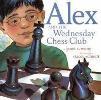|
Alex and the Wednesday Chess Club

Last updated Friday, February 17, 2012
Author: Janet S. Wong
Illustrator: Stacey Schuett
Date of Publication: 2004
ISBN: 0689858906
Grade Level: 3rd (GLCs: Click here for grade level guidelines.)
Date(s) Used: Nov. 2011
Synopsis:
From Booklist:
Four-year-old Alex loves chess until his neighbor's uncle, "moldy old" Uncle Hooya, dramatically trounces him. Traumatized, Alex stops playing until elementary school, when an injury on the football field leads him back to the game, and he joins his school chess club. Then, in his first tournament, he faces Uncle Hooya once again--when he plays against the older man's nephew. Wong's rhythmic, colloquial free verse combines the thrill of finding a talent with a child's anxieties, conveying the feelings in an age-appropriate voice: sometimes in a tournament "you do the first thing that pops into your mind, / which is really, really dumb, / but you really, really, really have to pee." Schuett's gouache-and-ink illustrations show a close-up cast of likable, multicultural kids supporting one another and facing off across the board. For young chess enthusiasts, this makes a good companion to David Birch's The King's Chessboard (1988), but all kids working hard to develop a passion will recognize Alex's excitement and his struggle to overcome disappointments.
| Discussion topics for before reading: |
| • |
Have you ever played chess?
|
| • |
What do you think members of a chess club would do? Practice? Learn new strategies/moves?
|
| • |
Have you ever been in a club? (RTK) What kind of clubs are at your school?
|
| • |
What are your favorite board games? Games involving strategy, decision making vs games involving luck, which one do you like more?
|
| • |
Do you like to play games or sports, even if you don't win?
Vocabulary
|
| • |
check
|
| • |
checkmate
|
| • |
rating/ranking
|
| Discussion topics for during/after reading: |
| • |
Do you like to focus on one game/activity or try several?
|
| • |
If you are nervous during a tournament or other type of competition, what are some good strategies to remember and practice to handle the stress?
|
| • |
Why are there different pieces? Chess was developed in Persian court as a means for the king to work out battle strategies.
|
| Craft ideas: |
| • |
Make your own chess/checker board- use a ruler to draw black (or another dark color) onto write paper.
|
| • |
Create your own chess/checker board-cut 8 strips of black&8 strips of white paper then weave together (leave edges on black paper for a border)
|
| • |
Make your own game with board and pieces.
|
*Note: These craft ideas are just suggestions.
You can use them, but you don't have to use them.
You can expand upon them, or add your own twist.
Remember, though, that the focus of your time should
not be on the development and execution of a craft;
the focus should be on the read-aloud and the
enjoyment of the book!
|
